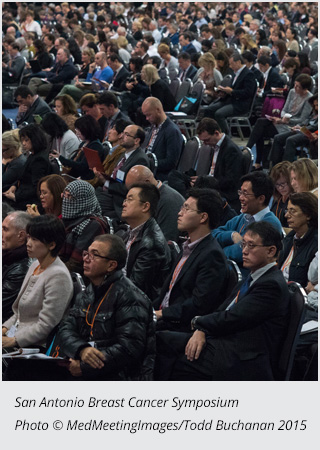Highlights from the 2015 San Antonio Breast Cancer Symposium
Finding the latest discoveries in breast cancer care together.

More than 7,000 breast cancer researchers, survivors, advocates, and others from 95 countries attended the 2015 San Antonio Breast Cancer Symposium (SABCS) in early December. The meeting, which is jointly sponsored by the Cancer Therapy & Research Center (CTRC) at UT Health Science Center San Antonio, the
American Association for Cancer Research (AACR), and Baylor College of Medicine, featured the latest developments in breast cancer research, including many that could quickly begin improving patient care.
Here, a look at some highlights:
Less is More
Two studies presented at the conference showed that breast-conserving surgery plus radiation may be a better option than mastectomy plus reconstruction for women with early-stage breast cancer because it reduces complications, improves long-term survival, and costs less.
Many women diagnosed with early-stage breast cancer worry about whether to choose mastectomy and reconstruction or breast-conserving therapy that includes lumpectomy and whole-breast irradiation. It can be tough to gauge the trade-offs between these two treatments in terms of outcome, side effects, costs to the patient, and costs to insurers, because such data are not readily available.
The two studies presented at SABCS provided data that could help women in their decision-making process. A study from the University of Texas MD Anderson Cancer Center compared costs and complications across several different kinds of breast cancer treatment, and in general, found that mastectomy and radiation carried the highest risk of complications and complication-related costs. This procedure was also the most expensive option for women with private insurance.
Separately, a study from the Netherlands focused on survival outcomes, and found that women who had breast-conserving therapy had better overall long-term survival than those who had mastectomy. The investigators argued that breast-conserving therapy should be the recommended treatment for small tumors, when it is medically feasible and according to a patient’s wishes.
These studies pack an emotional punch for a woman facing the decision about the best way to treat her case of breast cancer, but the financial element of these decisions can’t be forgotten, noted Benjamin D. Smith, MD, of MD Anderson.
“Our study findings are also particularly relevant from a payer’s perspective, given the growing emphasis placed on promoting treatments that are effective, safe, and cost-conscious,” he added.
Drug Developments
This year, several presentations showcased researchers’ efforts to improve patient outcomes through testing investigational new therapies, combinations, or choices of therapeutic treatment.
Anastrozole or tamoxifen?
Data from clinical trials showed that for women with estrogen receptor-positive ductal carcinoma in situ (DCIS), anastrozole and tamoxifen are both effective in reducing the chance of post-surgery disease recurrence. The side effects of the two drugs, however, differed, suggesting that the choice may depend on patients’ existing conditions related to the side effects from these two drugs rather than efficacy.
Women who took anastrozole experienced fewer endometrial and ovarian cancers and skin cancers than women who took tamoxifen. However, more strokes were seen among women taking anastrozole. These women also had more fractures, musculoskeletal issues, and vaginal dryness.
Women who took tamoxifen had more major thromboembolic events and gynecological issues, including hot flashes, vaginal hemorrhage, and discharge, compared with those who took anastrozole.
Battling HER2-positive breast cancer
Data from a phase III trial showed that trastuzumab emtansine (T-DM1 [Kadcyla]) improved median overall survival by about seven months for patients with HER2-positive, metastatic breast cancer that had progressed despite prior treatment with other HER2-targeted therapies, compared with those who received treatment of the physician’s choice.
Hans Wildiers, MD, PhD, professor of medical oncology at KU Leuven in Belgium, said at the symposium, “Here we show that T-DM1 actually increased overall survival for heavily pretreated patients with HER2-positive, metastatic breast cancer. This is very important because several breast cancer therapies that increase progression-free survival do not in fact increase overall survival, and these patients urgently need new treatment options.”
Boosting bone health and survival
Nearly all postmenopausal patients with hormone receptor-positive breast cancer currently receive treatment with aromatase inhibitors (AI), either alone or in sequence with tamoxifen, for five to 10 years, after completing their initial post-diagnosis treatment. Tamoxifen has a protective effect on bones, but adjuvant AI therapy compromises bone health, said Michael Gnant, MD, a professor of surgery at the Medical University of Vienna in Austria.
At SABCS, Gnant presented a study that showed that the monoclonal antibody denosumab (Xgeva) reduces both the risk of bone fractures and recurrence of cancer in early-stage patients. He said the outcome was dramatic enough that the Independent Data Monitoring Committee that oversees the clinical trial recommended unblinding the trial – allowing eligible trial patients to find out whether they were receiving denosumab or placebo, and switching to denosumab if they choose.
Gnant said the unblinding will occur in 2016, meaning that some cancer patients may benefit very soon from this year’s research.
To read about more exciting developments discussed at the conference, check out the coverage of the meeting from Cancer Today magazine and on the AACR’s blog,
Cancer Research Catalyst.
